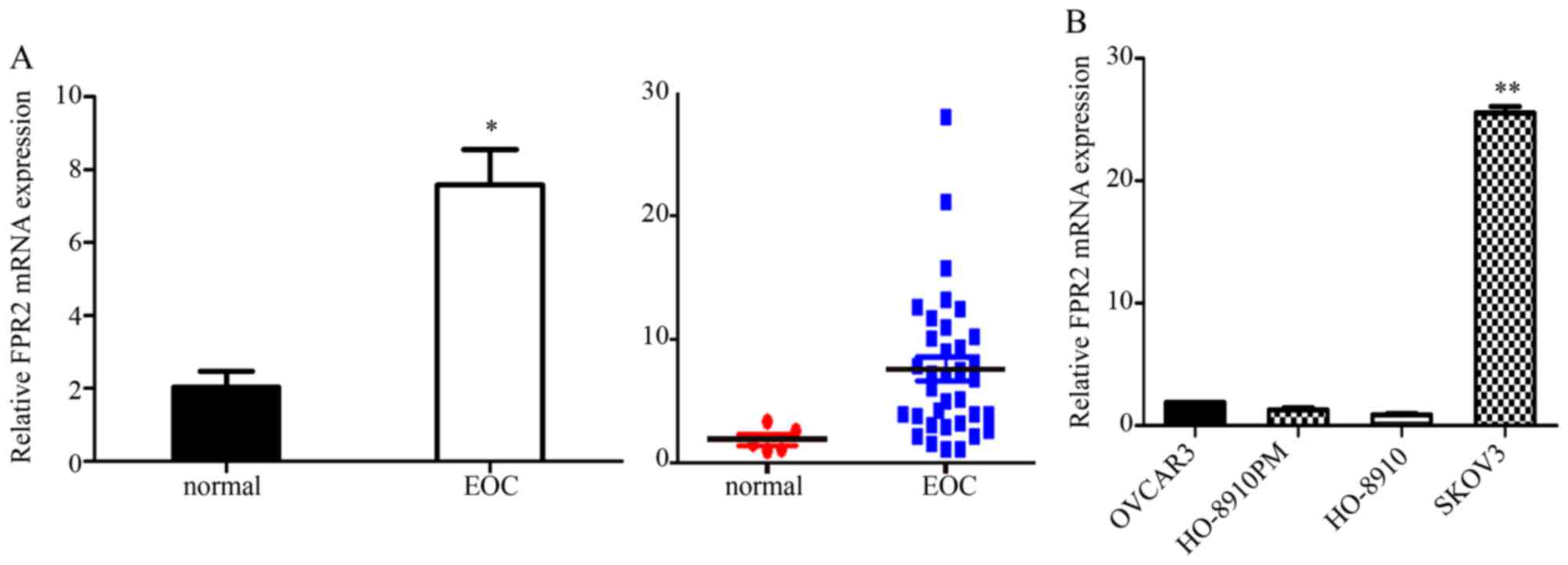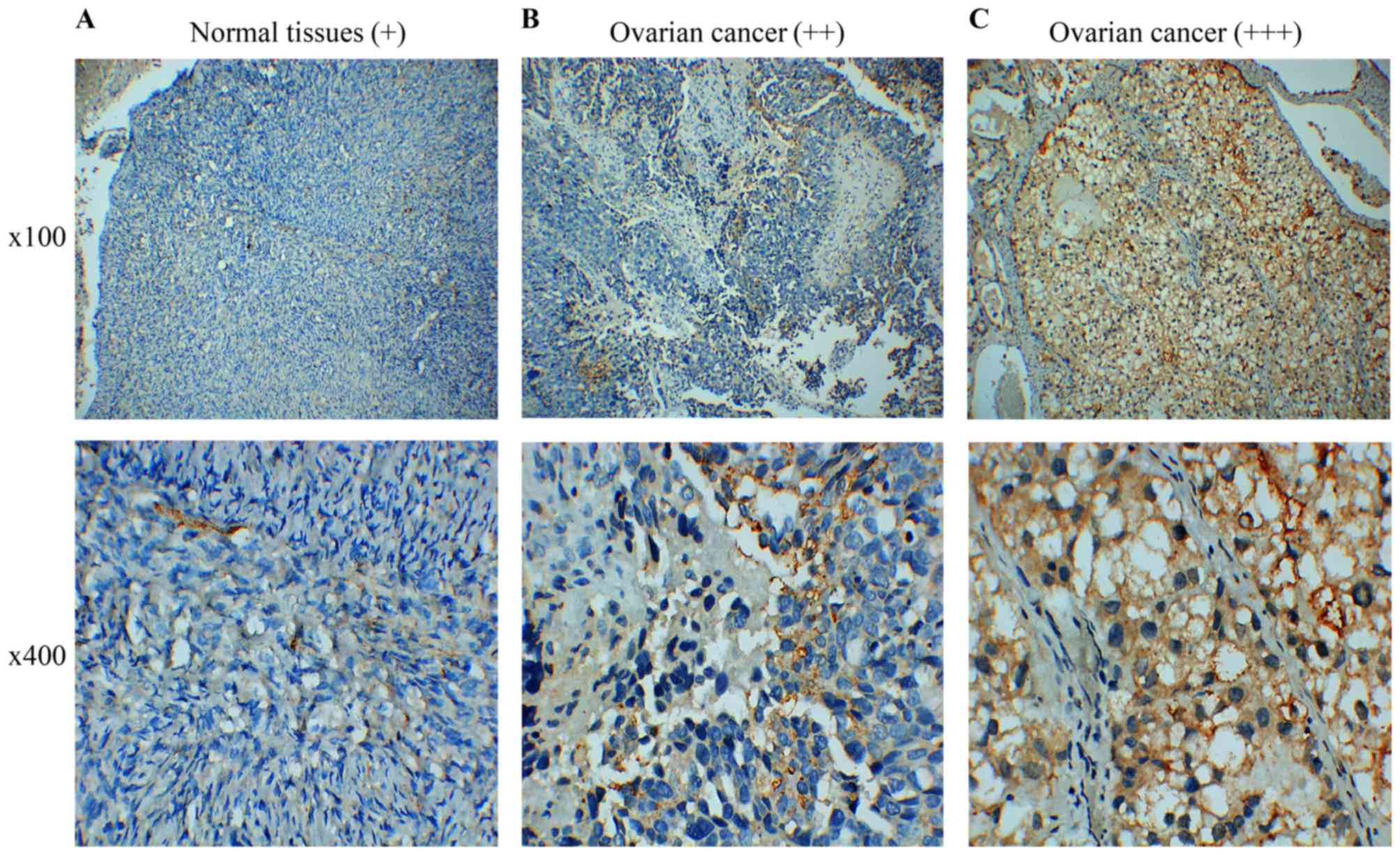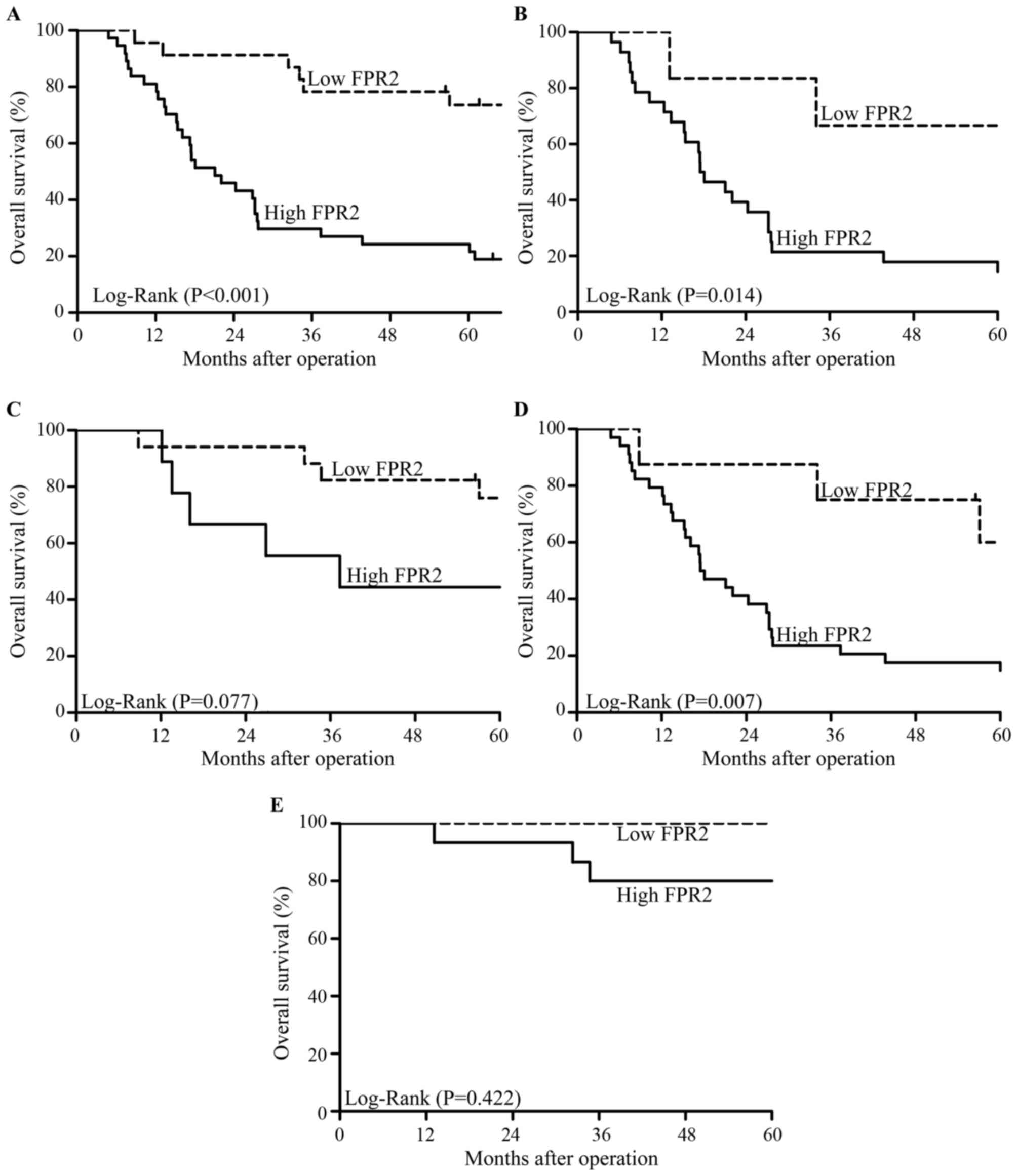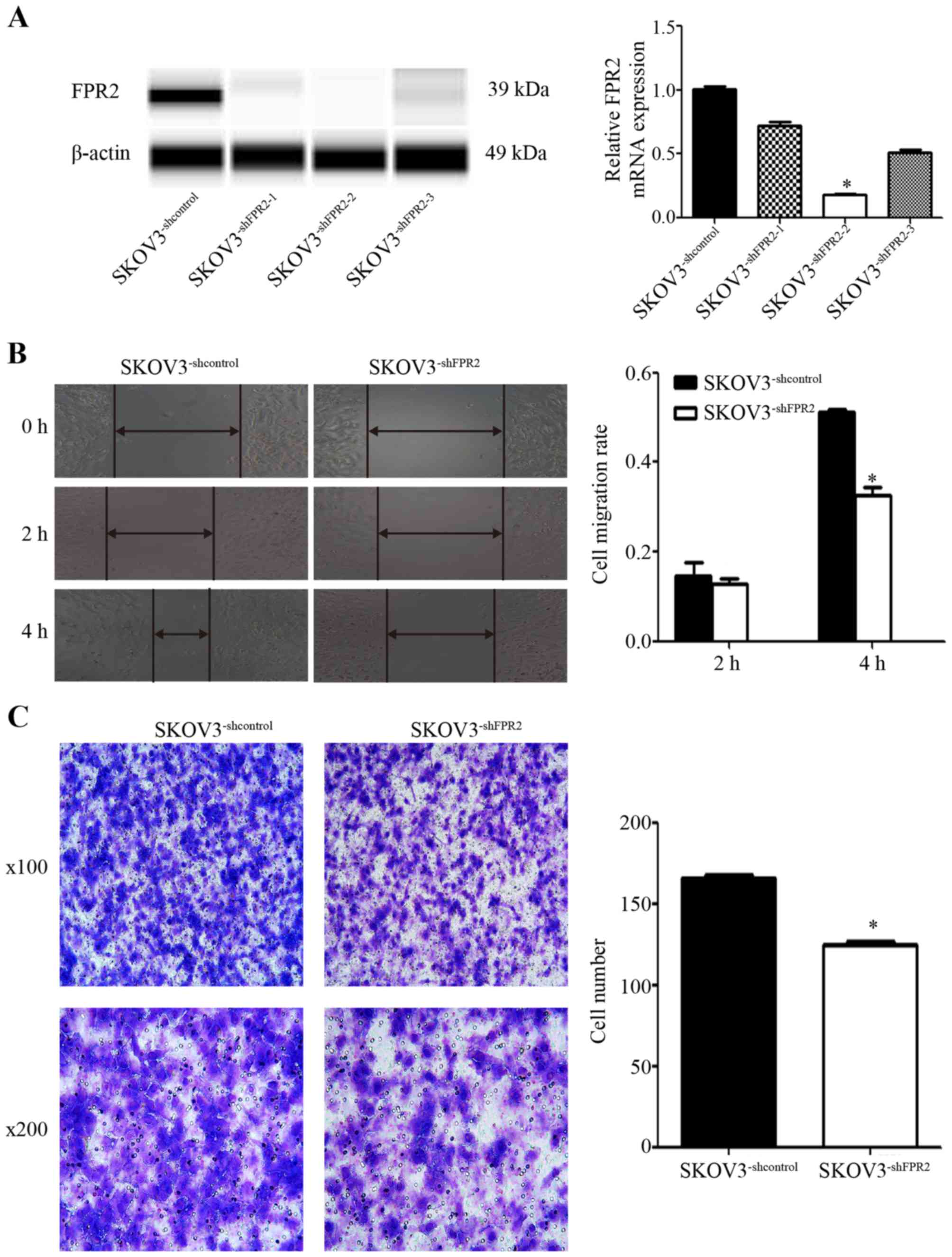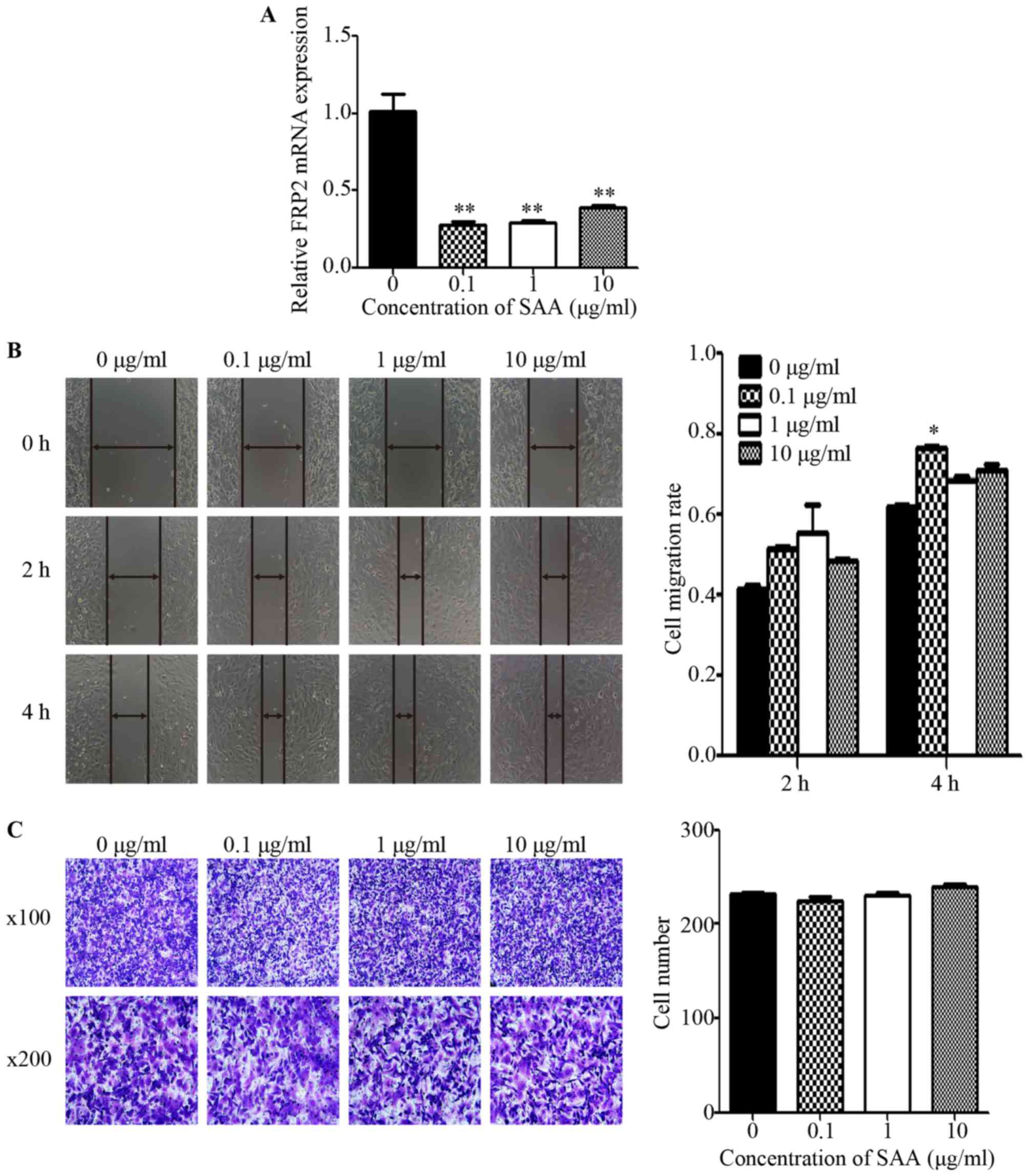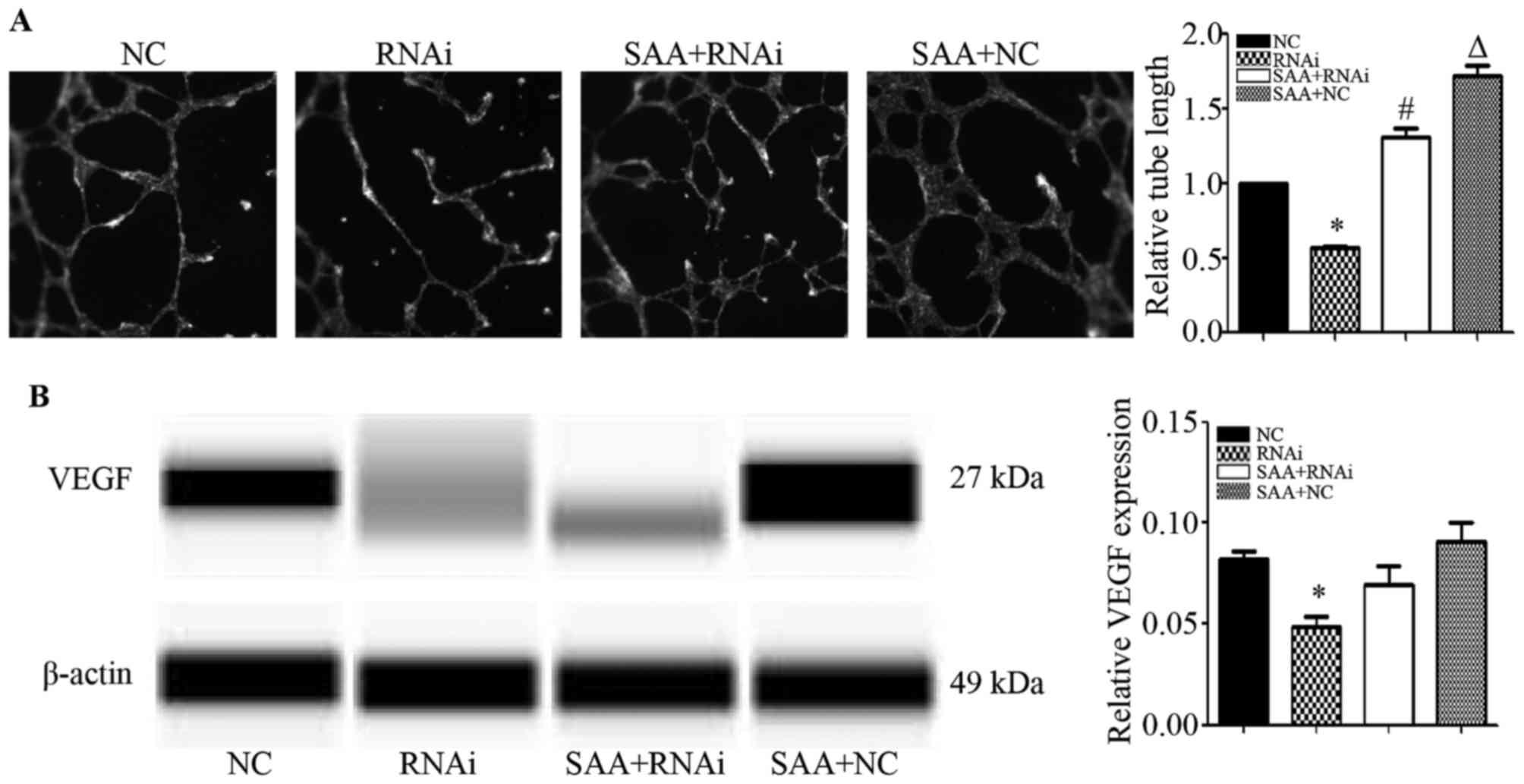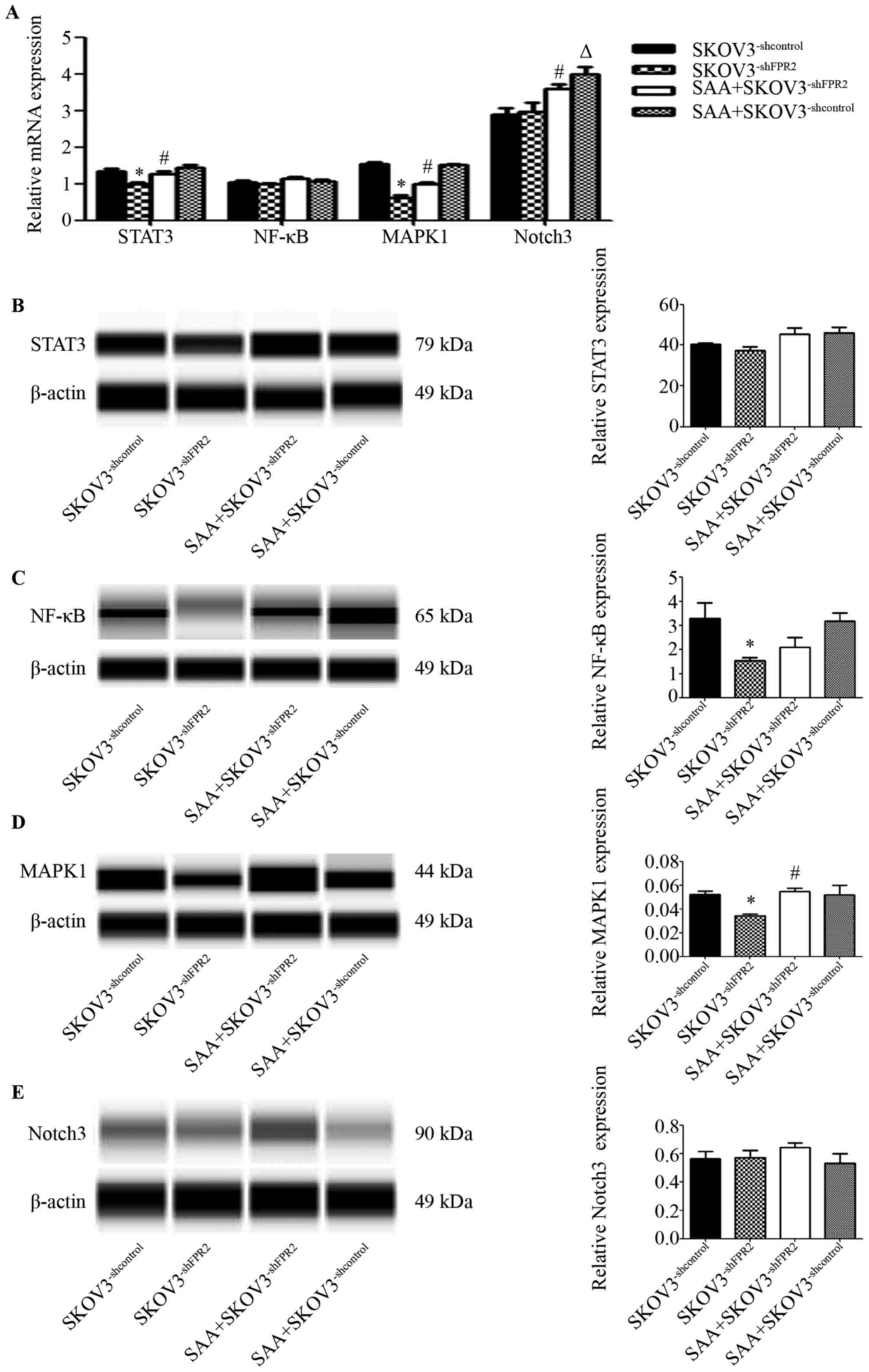Formyl peptide receptor 2 expression predicts poor prognosis and promotes invasion and metastasis in epithelial ovarian cancer
- Authors:
- Published online on: October 13, 2017 https://doi.org/10.3892/or.2017.6034
- Pages: 3297-3308
-
Copyright: © Xie et al. This is an open access article distributed under the terms of Creative Commons Attribution License.
Abstract
Introduction
Ovarian cancer is one of the deadliest gynecological cancers worldwide. The most recent update from the Cancer Statistics of America stated that ovarian cancer is the fifth most common cause of cancer-related deaths. In 2017, the number of newly diagnosed cases of ovarian cancer was projected to be ~22,440, and the number of deaths was predicted to be 14,080 (1). In 2015, the number of new cases of ovarian cancer in China was ~52,100, whereas the number of deaths was ~22,500; this places ovarian cancer as the seventh leading cause of cancer-related death among Chinese women (2). Among the diverse histological subtypes of ovarian cancer, epithelial ovarian cancer (EOC) accounts for ~85–90% of all types of ovarian carcinoma, and up to 75% of patients with EOC were diagnosed with advanced stage disease and were characterized by rapid progression, poor prognosis and a high frequency of TP53 mutations (3–5). The cause of EOC is still unclear, but in recent years, accumulating studies have demonstrated that inflammation plays an important role in ovarian cancer tumorigenesis and progression (6–9).
Formyl peptide receptor 2 (FPR2) has been identified as a member of the G protein-coupled chemoattractant receptor (GPCR) family. It is a seven-transmembrane receptor with 351 amino acids and is located on human chromosome 19q13.3-q13.4 (10). It was first detected on the cell membrane of macrophages and neutrophils and is activated by bacterial formylated chemotactic peptides. FPR2 was later reported to be expressed in a wide range of cells, tissues and organs, including inflammatory, microglial and astrocytoma and neuroblastoma cells, hepatocytes, microvascular endothelial cells, fibroblasts, spleen, lung, testes, ovaries, placenta, brain and bone marrow (11,12). FPR2 is a multi-functional receptor that is associated with diverse pathophysiologic processes, such as inflammation, cancer, amyloidosis and neurodegenerative diseases, wound healing, diabetes and obesity and AIDS (13). There is also a close relationship between FPR2 and cancer, as FPR2 has been detected via flow cytometry in seven ovarian cancer cell lines and the FPR2 agonist-antimicrobial peptide LL-37 was suggested to stimulate the invasiveness of ovarian cancer cells by interacting with FPR2 (14). FPR2 has been proposed as a bridge between inflammation and cancer. Serum amyloid A (SAA) is an acute phase protein that can be stimulated by inflammation, infection, trauma or tumorigenesis. In a study of Urieli-Shoval et al, SAA was found to be strongly expressed in ovarian cancer tissues by IHC, ISH and RT-PCR (15). SAA is one of the primary agonists of FPR2, and previous studies have suggested that SAA-induced activation of FPR2 stimulates inflammation, cell migration, adhesion and infiltration (16). The SAA-FPR2 interaction also contributes to inflammation-mediated neovascularization in the cornea (17). Thus, we hypothesized that SAA may be expressed by ovarian cancer cells and interacts with FPR2 to stimulate ovarian cancer invasion and migration. In the present study, we explored the effects of FPR2 in the presence or absence of SAA on EOC progression.
Materials and methods
Quantitative real-time PCR
Total RNA was extracted from either tissues or cells using TRIzol reagents (Pufei Biotechnology, Shanghai, China). Reverse transcription was performed using M-MLV reverse transcriptase following the manufacturer's instructions (Promega, Madison, WI, USA). We used 2 µg of total RNA in a sterile RNase-free microcentrifuge tube, and then added 0.5 µg of the primer or per microgram of the total RNA sample in a total volume of 15 µl in water. The tube was heated to 70°C for 5 min to melt secondary structure within the template. The tube was cooled immediately on ice to prevent secondary structure from reforming, and then spinned briefly to collect the solution at the bottom of the tube. Then, the following components were added to the annealed primer/template: M-MLV 5X reaction buffer 5 µl; dATP, 10 mM 1.25 µl; dCTP, 10 mM 1.25 µl; dGTP, 10 mM 1.25 µl; dTTP, 10 mM 1.25 µl; recombinant RNasin ribonuclease inhibitor 25 units; M-MLV RT 200 units; nuclease-free water to a final volume of 25 µl. Gentle mixing was performed by flicking the tube, and incubation was carried out for 60 min at 42°C for FPR2 primers. The extension temperature was 37°C. Quantitative PCR was performed using SYBR-Green Real-Time PCR Master Mix (Toyobo, Osaka, Japan) according to the manufacturer's protocol. The primer sequences were as follows: FPR2 forward, 5′-AGTCTGCTGGCTACACTGTTC-3′ and reverse, 5′-TGGTAATGTGGCCGTGAAAGA-3′; STAT3 forward, 5′-AGAAGGACATCAGCGGTAAG-3′ and reverse, 5′-CCTTGGGAATGTCAGGATAGAG-3′; NF-κB forward, 5′-AGGATTTCGTTTCCGTTATGT-3′ and reverse, 5′-CCTGAGGGTAAGACTTCTTGTTC-3′; MAPK1 forward, 5′-GTCGCCATCAAGAAAATCAGC-3′ and reverse, 5′-GGAAGGTTTGAGGTCACGGT-3′; Notch3 forward, 5′-TGTGGACGAGTGCTCTATCG-3′ and reverse, 5′-AATGTCCACTCGCAATAGG-3′; GAPDH forward, 5′-TGACTTCAACAGCGACACCCA-3′ and reverse, 5′-CACCCTGTTGCTGTAGCCAAA-3′.
Immunohistochemistry (IHC)
The ovarian cancer tissues were fixed in 10% formalin and paraffin-embedded to form tissue blocks from which sections (4-µm thickness) could be sliced for IHC studies. The tissue sections were deparaffinized in xylene and rehydrated in graded concentrations of alcohol, and then were placed in a microwave for 30 min for antigen retrieval. After the slides were dewaxed, 3% H2O2 was added for 10 min to inhibit any endogenous peroxidase activity. The sections were incubated with the FPR2 antibody (13448–1-AP; 1:50 dilution; Proteintech, San Diego, CA, USA) at 4°C overnight and subsequently incubated with a streptavidin-peroxidase system (Zhongshan Goldenbridge Biotechnology, Beijing, China) according to the manufacturer's instructions.
Cell culture
The human ovarian cancer cell lines SKOV3, OVCAR3 and the HUVECs were obtained from the America Type Culture Collection (ATCC; Manassas, VA, USA), and the HO-8910 and HO-8910PM cell lines were obtained from the China Center for Type Culture Collection (CCTCC). The cell lines were cultured in either Dulbeccos modified Eagles medium (DMEM) or RPMI-1640 medium supplemented with 10% fetal bovine serum (FBS) and 100 UI/ml of penicillin and 100 mg/ml of streptromycin (all from Biological Industries, Cromwell, CT, USA) in a 37°C incubator containing 5% CO2.
Vector construction and transfection
The FPR2 knockdown and control lentiviruses were purchased from GeneChem (Shanghai, China). The shRNA sequences for FPR2 knockdown were as follows: shRNA-1, ccggAATCATTGACAT CCTGGTTAActcgagTTAACCAGGATGTCAATGATTtttttg; shRNA-2, ccggGGCCAAGACTTCCGAGAGAGActcgagTC TCTCTCGGAAGTCTTGGCCtttttg; shRNA-3, ccggGTCC TATGAGTCTGCTGGCTActcgagTAGCCAGCAGACTCAT AGGACtttttg. The shRNA-2 sequence exhibited the best interference efficiency.
Wound-healing assay
Cells (3×104/well) were seeded on 96-well plates and grown to 90% confluence, after which a scratch was made in the monolayer using a 10-µl pipette tip. Then, the cells were incubated at 37°C in 5% CO2 for another 4 h according to the result of the pre-experiment, and the images were obtained at the time points of 0, 2 and 4 h. Each experiment was performed three times.
Transwell assay
The assay was performed using a pre-coated cell invasion kit (pore size, 8.0 µm; Corning Inc., Corning, NY, USA) and Matrigel (BD Biosciences, Bedford, MA, USA) was inserted in the upper chambers. Approximately 1×105 cells in 100 µl serum-free medium were placed into the upper chambers, the cells were cultured in 5% CO2 at 37°C for 16 h (according to the pre-experiment). The lower chambers contained 30% FBS, thus, the cells migrated to the lower chambers. The cells remaining in the upper chambers were removed with a cotton swab and the cells that migrated through the membrane to the lower surface were stained with Giemsa's staining for 3–5 min at room temperature. The number of cells that migrated through the lower membrane of the inserts was counted under a light microscope. Each experiment was performed three times.
Tube formation assay
HUVECs (4×104 cells/well) were seeded on Matrigel-coated 96-well plates and incubated at 37°C. Serum-free supernatant from SKOV3, shFPR2 SKOV3, SAA+shFPR2 SKOV3 and SAA+SKOV3 cells were collected and centrifuged. The supernatants were then incubated with the HUVECs at 37°C for 24 h. Afterwards, the cells were fixed with 4% paraformaldehyde at 37°C for 15 min and the capillary-like structures were obtained using Cellomics (CCX7C1115; Thermo Fisher Scientific, Waltham, MA, USA). Branching points and lengths were measured using ImageJ software [National Institutes of Health (NIH), Bethesda, MD, USA]. Each experiment was performed three times.
Simple Western (WES)
Proteins from ovarian cancer cells were extracted in RIPA lysis buffer (P0013B; Beyotime Biotechnology, Shanghai, China.). The protein concentrations were determined using a BCA protein assay (Bio-Rad Laboratories, Inc., Hercules, CA, USA). The samples and reagent were subsequently loaded into an assay plate and placed in a ProteinSimple WES system (WS-2471; ProteinSimple, San Jose, CA, USA.) according to the standard protocol. Finally, the resulting chemiluminescent signal was detected and quantitated by ProteinSimple Compass software. The following antibodies were used: FPR2 (13448-1-AP; 1:20 dilution; Proteintech), VEGF (Ab183100, 1:20 dilution, Abcam, Cambridge, MA, USA), STAT3 antibodies (9139; 1:20 dilution), MAPK1 (4376; 1:20 dilution), Notch3 (2889; 1:20 dilution) [all from Cell Signaling Technology (CST; Beverly, MA, USA)], and β-actin (69879; 1:50; Santa Cruz Biotechnology, Inc., Santa Cruz, CA, USA).
Statistical analysis
Statistical analysis was performed using IBM SPSS Statistics 24.0 (IBM SPSS, Armonk, NY, USA). Statistics of continuous data were made using AVOVA or Student's t-test, while Chi-square test was used for categorical data. At least three independent experiments for each group were conducted, and differences in mean values were assessed by analysis of variance and Student's t-test. The survival curves were generated using the Kaplan-Meier method and calculated using the log-rank test. Prognostic factors were evaluated using Cox regression analysis. P-value <0.05 was considered to indicate a statistically significant result.
Results
Increased expression of FPR2 in EOC
We used RT-qPCR to analyze the FPR2 expression in both EOC tissues and cells. We collected 35 cases of EOC tissues and five normal ovarian tissues samples for RT-qPCR assay. The results indicated that FPR2 mRNA expression was frequently higher in the ovarian cancer samples than that noted in the control group. Then, we detected FPR2 mRNA expression in four ovarian cancer cell lines including SKOV3, OVCAR3, HO-8910 and HO-8910PM. The results showed that FPR2 mRNA expression was significantly higher in the SKOV3 cell line than that in the other three ovarian cancer cell lines (Fig. 1); thus, we selected the SKOV3 cell line as a target cell line for FPR2 knockdown to perform the further cell functional experiments. Subsequently, we collected 60 cases of paraffin-embedded EOC specimens and 5 cases of normal ovarian tissue specimens for IHC assay. The results indicated that FPR2 protein expression was frequently higher in the ovarian cancer samples than that in the control group as shown by IHC. FPR2 expressed on the cytomembrane or cytoplasm of EOC cells was considered as a positive result. The staining of the entire slide was scored according to intensity: +, weak; ++, moderate; and +++, strong). The score was calculated using the following formula: (3 × percentage of strong staining) + (2 × percentage of moderate staining) + (1 × percentage of weak staining), with the possible scores ranging from 0 to 300. FPR2 expression was classified into two groups according to a cut-off score of 100 (0–99 = low/negative expression; 100–300 = high/positive expression) (Fig. 2) (18).
FPR2 expression level is correlated with the clinicopathological characteristics of EOC
Analysis of the correlation between FPR2 expression and the clinicopathological characteristics of the EOC patients showed that high levels of FPR2 expression indicated a significant positive correlation with International Federation of Gynecology and Obstetrics (FIGO) stage, histological grade and ovarian cancer type (19). (Tables I and II).
Table I.Correlation between FPR2 mRNA expression and clinicopathological characteristics of the EOC cases. |
Table II.Correlation between FPR2 protein expression and clinicopathological characteristics of the EOC cases. |
FPR2 overexpression is associated with poor prognosis in EOC
We followed up 60 cases of EOC patients for 5 years after surgery. A total of 36 deaths occurred during follow-up and all cases died due to cancer or cancer-related diseases. The Kaplan-Meier survival analysis showed that patients with high FPR2 expression had a lower overall survival (OS) than those with low FPR2 expression (Fig. 3A). In addition, in high-grade EOC patients, high FPR2 expression indicated a lower OS than a low FPR2 expression; whereas, OS showed no significant difference among low-grade EOC patients regardless of the expression of FPR2 (Fig. 3B and C). Moreover, in advanced FIGO stage EOC patients, high FPR2 expression was associated with a lower OS compared with a low FPR2 expression; whereas, OS showed no significant difference among patients in early FIGO stage of EOC regardless of the expression of FPR2 (Fig. 3D and E). Univariate and multivariate analyses showed that high FPR2 expression was a risk factor for EOC patients (Table III).
FPR2 knockdown reduces the invasion and migration of SKOV3 cells
To study the role of FPR2 in ovarian cancer migration, we stably transduced FPR2shRNA into SKOV3 (SKOV3−shFPR2) cells and verified FPR2 expression using RT-qPCR and WES (Fig. 4A). The wound healing and Transwell assays were used to detect the metastatic potential of SKOV3−shFPR2 cells, with more active motility of the tumor cells corresponding to increased metastatic potential. The results of wound healing assay showed that 4 h after scraping, the average migration rate of the SKOV3−shFPR2 cells was significantly decreased (Fig. 4B). The Transwell assay also indicated that compared to the control cells, fewer SKOV3−shFPR2 cells penetrated the Matrigel (Fig. 4C).
SAA promotes the motility of ovarian cancer cells via FPR2
In SKOV3 cells treated with SAA (0.1, 1 and 10 µg/ml) for 48 h, the mRNA expression of FPR2 was markedly decreased compared to the untreated control group (Fig. 5A). Then, we performed wound healing and Transwell assays to detect cell motility. The wound healing assay revealed that the average migration rate of the SKOV3 cells was significantly increased after treatment with 0.1 µg/ml SAA at 4 h after scraping (Fig. 5B). However, the Transwell assay showed no significant difference among the SAA treatment groups regarding the number of cells that penetrated the Matrigel when compared to the untreated control group (Fig. 5C). To investigate whether SAA mediates ovarian cancer cell migration through FPR2, 0.1 µg/ml SAA was added to SKOV3−shFPR2 and SKOV3−shcontrol cells for 48 h, and the wound healing and Transwell assays were performed. The results showed that the average migration rate of the SAA+SKOV3−shFPR2 cells was significantly decreased (Fig. 5D), and Transwell assay indicate that compared to the control cells, fewer SAA+SKOV3−shFPR2 cells penetrated the Matrigel (Fig. 5E).
FPR2 knockdown reduces the angiogenesis of SKOV3 cells
To study the effect of FPR2 on the angiogenesis of ovarian cancer cells, we treated HUVECs with the cell culture media from each cell type for 24 h. The results showed that compared to the SKOV3−shcontrol (NC) group, the FPR2-knockdown (RNAi) group exhibited significantly shorter tube lengths. Additionally, when compared to the SKOV3−shFPR2 (RNAi) group, the SAA+SKOV3−shFPR2 (SAA+RNAi) group markedly increased the angiogenic ability of the HUVECs. Compared to the SKOV3−shcontrol (NC) group, the SAA+SKOV3−shcontrol (SAA+NC) group markedly increased the angiogenic ability of the HUVECs (Fig. 6A). The WES results showed that the FPR2-knockdown group exhibited significantly decreased VEGF expression compared to that of the NC group (Fig. 6B).
The signaling pathways activated by FPR2 in SKOV3 cells
To study the potential mechanism of FPR2 regulation in SKOV3 cells, we used RT-qPCR and WES to detected several reported genes that are correlated with inflammation and ovarian cancer. These genes included STAT3, NF-κB, MAPK1 and Notch3. The RT-qPCR results showed that mRNA expression of STAT3 and MAPK1 was evidently downregulated in the SKOV3−shFPR2 cells compared to those in the SKOV3−shcontrol cells (Fig. 7A). The WES results indicated that protein levels of MAPK1 and NF-κB were evidently downregulated in the SKOV3−shFPR2 cells compared to those in the SKOV3−shcontrol cells (Fig. 7C and D). Expression of STAT3 protein and Notch3 protein showed no significant difference between groups (P>0.05) (Fig. 7E)
Discussion
In the present study, we first demonstrated that FPR2 was upregulated in ovarian cancer tissues. The literature describes the initial discovery of FPR2 in inflammatory cells, but additional studies have stated that this protein is expressed in a variety of cells (including cancer cells) and binds ligands produced under inflammatory or tumor conditions (10–12). Oldekamp et al reported that among mice infected with pneumococcus, mFPR1-knockout and mFPR2-transgenic mice presented increased bacterial burden, elevated neutrophil infiltration and high mortality compared to wild-type mice. This suggests that FPR1 and FPR2 play significant roles in the innate immune response (20). Coffelt et al demonstrated that ovarian cancer cell lines express FPR2 to varying degrees. Human cathelicidin LL-37 stimulates the invasion of ovarian cancer cells via FPR2, and oncogenes such as c5, coll8al and mmp2 are upregulated in ovarian cancer cells (14). FPR2 has also been shown to act as a promoter in other types of malignancies. In a study by Xiang et al, FPR2 was detected both in vivo and in vitro in human colon cancer. Additionally, FPR2 was demonstrated to be highly expressed in progressive colon cancer, correlated with a worse patient prognosis and play a role in stimulating tumorigenesis and invasion in colon cancer cells (21). Khau et al showed that FPR2 protein could be detected in both epithelial and stromal cells of breast cancer tissues and was shown to promote mitogens in breast cancer cells (22). In the present study, we showed that FPR2 is highly expressed in ovarian cancer tissues using both IHC and RT-qPCR. Subsequently, upon analyzing the correlation of FPR2 expression with clinicopathological characteristics, we discovered that FPR2 expression was correlated with FIGO stage, histological grade and ovarian cancer type, which suggests that FPR2 may be associated with the progression of ovarian cancer. In survival analysis, we found that FPR2 overexpression indicated a poorer prognosis of epithelial ovarian cancer (EOC) patients and suggested that FPR2 may be an independent risk factor for EOC, which has not been reported before. As shown in cell experiments, the knockdown of FPR2 resulted in inhibition of ovarian cancer cell movement, indicating that FPR2 may contribute to the metastasis of ovarian cancer. In the future, we intend to enlarge the sample size and add a validation cohort study as well as more experiments may be performed to demonstrate the role that FPR2 plays in ovarian cancer.
The acute phase protein SAA is a biomarker for ovarian tumorigenesis and prognosis (15,23). Liang et al reported that SAA acts as an agonist for FPR2. In mouse neutrophils, SAA binds FPR2 to induce calcium flux and chemotaxis (16). As reported by Sodin-Semrl et al, FPR2 was shown to participate in SAA-induced release of IL-8, IL-6, and MMP-3 proteins as well as upregulation of NF-κB and AP-1 DNA binding activity in fibroblast-like synoviocytes (24). SAA and FPR2 mediate the migration, adhesion and tissue infiltration of inflammatory cells, and these physiological processes can be adapted for tumor development in the study of Badolato et al (25). In the present study, we found that SAA reduced the FPR2 mRNA expression levels as assessed by RT-qPCR, whereas the results of the wound healing assay revealed that SAA may stimulate the migration of SKOV3 cells. However, the migratory potential was significantly decreased upon FPR2 knockdown; thus, we suggest SAA may utilize FPR2 molecules expressed on the membranes of ovarian cancer cells. We did not note any other studies similar to ours; however, there are similar studies that we may use to illustrate the results. Aβ4 is also a chemotactic agonist for FPR2. According to Yazawa et al, when FPR2/293 cells were co-cultured with Aβ4, Aβ4/FPR2 complexes could be detected in the cytoplasmic region and no FPR2 could be detected on the cell surface (26). It is a common feature for G protein-coupled receptors (GPCRs) to undergo internalization after ligand binding, which may involve different pathways. GPCR expression levels are a balance of three highly regulated, dynamic intracellular trafficking processes, called export, internalization and degradation (27). Thus, we hypothesized that incubation of ovarian cancer cells with continued SAA may induce the internalization of FPR2 in association with SAA and subsequently result in the degradation of FPR2. Actually, we focused on only the first small step in this hypothesis, and there is further research that is required.
Next, we studied the effect of FPR2 on the angiogenesis of ovarian cancer cells. Angiogenesis occurs during both inflammation and tumorigenesis, as sprouting new vessels provide oxygen and nutrition for sites of wound healing and tumor development. It is considered an essential process for oncogenesis. According to Byrne et al, in ovarian cancer, angiogenesis is associated with tumor growth, peritoneal implants and ascites formation (28). In the present study, the tube formation potential was decreased after FPR2 knockdown, which suggests that FPR2 contributes to angiogenesis to some extent, whereas SAA could stimulate tube formation regardless of the FPR2 expression levels. This finding may be attributed to FPR2 expression on the HUVEC plasma membrane. Tumor angiogenesis is regulated by angiogenic stimulators such as the VEGF family and fibroblast growth factors. Perren et al demonstrated that anti-angiogenesis therapy is considered a new strategy for treating ovarian cancer. Bevacizumab, a humanized anti-VEGF monoclonal antibody, is the most widely studied therapy that was shown to prolong the progression-free survival (PFS) of ovarian cancer patients (29). In inflamed corneas of mice, the SAA/FPR2/MMP pathway was reported to stimulate corneal neovascularization (17). According to Lu et al, SAA induced VEGFR2 expression and angiogenesis via FPR2 on HUVECs and activated downstream MAPKs (30). In the present study, we found that VEGF expression was downregulated upon FPR2 knockdown, which is consistent with the results of the above-mentioned studies.
Our subsequent experiments indicated that STAT3, NF-κB and MAPK1 may be mediated by FPR2 to promote SKOV3 cell migration. It was suggested that pro-inflammatory cytokines such as tumor necrosis factor and interleukins trigger signaling cascades that directly or indirectly activate key transcription factors, including AP-1, NF-κB, STAT3, YAP and Notch, that control tumor promotion and progression, cell cycle, cell death, dedifferentiation, stemness, motility and migration (31,32). We found STAT3 mRNA was downregulated in FPR2-knockdown cells. According to Kim et al, STAT3 is a transcription factor located in the cytoplasm that transduces extracellular signals to the nucleus. STAT3 modulates the transcription of a variety of genes to regulate important biological functions, including cell proliferation, differentiation, survival, angiogenesis and the immune response (33), and plays a prominent role in tumor growth and invasion. In the study of Cai et al, STAT3 knockdown downregulated the expression of oncogenes such as cyclin D1, survivin and VEGF, which led to tumor suppression and apoptosis in ovarian cancer (34). Cattaneo et al suggested that activation of FPR2 induces the phosphorylation of the Y1313/Y1349/Y1356 residues of c-Met and triggers some of the molecular responses elicited by c-Met/HGF binding, including the STAT3, PLC-γ1/PKCα and PI3K/Akt pathways (35). These studies are in accordance with our results to some extent. Our Simple Western results showed that NF-κB protein was downregulated in FPR2-knockdown SKOV3 cells. NF-κB is a nuclear transcription factor that plays an essential role in inflammation, innate immunity and cancer. According to Kam et al, FPR2 can activate NF-κB signaling via inhibitor-κB kinase (IKK) phosphorylation, and they suggested that NF-κB may be a potential therapeutic target for FPR2-related diseases (36). These data combined with our results indicate that FPR2 may promote ovarian cancer cell migration through NF-κB. The present study showed that MAPK1 expression was downregulated in FPR2-knockdown SKOV3 cells as shown by both RT-qPCR and Simple Western. MAPKs act as key regulators in multiple biological processes such as cell proliferation, death, differentiation, migration and invasion. Previous studies have reported that the MAPK pathway is activated in ovarian cancer. Manzano et al confirmed that downregulation of CL100, which is an endogenous dual-specificity phosphatase known to inhibit MAPK, could stimulate human ovarian cancer progression by promoting the MAPK pathway (37). Additionally, the expression of receptors, including FPR2, BLTR and CXCR1, on neutrophils was downregulated when p38MAPK was blocked, which suggests that p38MAPK plays an essential role in neutrophil chemotaxis (38). In the present study, SAA exerted no obvious effects on stimulating MAPK expression via FPR2. LL-37, another agonist peptide of FPR2, was also demonstrated to activate the MAPK signaling pathway in ovarian cancer cells despite inhibiting FPR2 (14). Previous research showed that Notch3 was preferentially upregulated and prevalent; furthermore, this upregulation was significantly correlated with the poor clinical outcomes of ovarian cancer patients (39). There is no research that indicates the correlation between FPR2 and the Notch signaling pathway. In the present study, we did not observe any evidence to prove the relationship between SAA/FPR2 activation and Notch signaling.
In conclusion, our results demonstrated that FPR2 was significantly overexpressed in EOC and was positively correlated with clinicopathological features including FIGO stage, histological grade and high grade ovarian cancer. High FPR2 expression also indicated the poor prognosis of EOC patients. Additionally, FPR2 knockdown decreased the migratory ability of SKOV3 cells, which indicates that FPR2 is essential for invasion and metastasis of EOC. We also observed that STAT3, NF-κB and MAPK1 expression may be affected by FPR2 function. In the future, xenograft models may be used for further research and the mechanisms of signaling molecules that are involved in the efffects of FPR2 on ovarian cancer also require more detailed research.
References
|
Siegel RL, Miller KD and Jemal A: Cancer Statistics, 2017. CA Cancer J Clin. 67:7–30. 2017. View Article : Google Scholar : PubMed/NCBI | |
|
Chen W: Cancer statistics: Updated cancer burden in China. Chin J Cancer Res. 27:12015. View Article : Google Scholar : PubMed/NCBI | |
|
Herzog TJ and Pothuri B: Ovarian cancer: A focus on management of recurrent disease. Nat Clin Pract Oncol. 3:604–611. 2006. View Article : Google Scholar : PubMed/NCBI | |
|
Malpica A, Deavers MT, Lu K, Bodurka DC, Atkinson EN, Gershenson DM and Silva EG: Grading ovarian serous carcinoma using a two-tier system. Am J Surg Pathol. 28:496–504. 2004. View Article : Google Scholar : PubMed/NCBI | |
|
Kurman RJ and Shih IeM: The origin and pathogenesis of epithelial ovarian cancer: A proposed unifying theory. Am J Surg Pathol. 34:433–443. 2010. View Article : Google Scholar : PubMed/NCBI | |
|
Hunn J and Rodriguez GC: Ovarian cancer: Etiology, risk factors, and epidemiology. Clin Obstet Gynecol. 55:3–23. 2012. View Article : Google Scholar : PubMed/NCBI | |
|
Lin HW, Tu YY, Lin SY, Su WJ, Lin WL, Lin WZ, Wu SC and Lai YL: Risk of ovarian cancer in women with pelvic inflammatory disease: A population-based study. Lancet Oncol. 12:900–904. 2011. View Article : Google Scholar : PubMed/NCBI | |
|
Risch HA and Howe GR: Pelvic inflammatory disease and the risk of epithelial ovarian cancer. Cancer Epidemiol Biomarkers Prev. 4:447–451. 1995.PubMed/NCBI | |
|
Seidman JD, Sherman ME, Bell KA, Katabuchi H, O'Leary TJ and Kurman RJ: Salpingitis, salpingoliths, and serous tumors of the ovaries: Is there a connection? Int J Gynecol Pathol. 21:101–107. 2002. View Article : Google Scholar : PubMed/NCBI | |
|
Ye RD, Boulay F, Wang JM, Dahlgren C, Gerard C, Parmentier M, Serhan CN and Murphy PM: International Union of Basic and Clinical Pharmacology. LXXIII. Nomenclature for the formyl peptide receptor (FPR) family. Pharmacol Rev. 61:119–161. 2009. View Article : Google Scholar : PubMed/NCBI | |
|
Becker EL, Forouhar FA, Grunnet ML, Boulay F, Tardif M, Bormann BJ, Sodja D, Ye RD, Woska JR Jr and Murphy PM: Broad immunocytochemical localization of the formylpeptide receptor in human organs, tissues, and cells. Cell Tissue Res. 292:129–135. 1998. View Article : Google Scholar : PubMed/NCBI | |
|
Migeotte I, Communi D and Parmentier M: Formyl peptide receptors: A promiscuous subfamily of G protein-coupled receptors controlling immune responses. Cytokine Growth Factor Rev. 17:501–519. 2006. View Article : Google Scholar : PubMed/NCBI | |
|
Li Y and Ye D: Molecular biology for formyl peptide receptors in human diseases. J Mol Med. 91:781–789. 2013. View Article : Google Scholar : PubMed/NCBI | |
|
Coffelt SB, Tomchuck SL, Zwezdaryk KJ, Danka ES and Scandurro AB: Leucine leucine-37 uses formyl peptide receptor-like 1 to activate signal transduction pathways, stimulate oncogenic gene expression, and enhance the invasiveness of ovarian cancer cells. Mol Cancer Res. 7:907–915. 2009. View Article : Google Scholar : PubMed/NCBI | |
|
Urieli-Shoval S, Finci-Yeheskel Z, Dishon S, Galinsky D, Linke RP, Ariel I, Levin M, Ben-Shachar I and Prus D: Expression of serum amyloid a in human ovarian epithelial tumors: Implication for a role in ovarian tumorigenesis. J Histochem Cytochem. 58:1015–1023. 2010. View Article : Google Scholar : PubMed/NCBI | |
|
Liang TS, Wang JM, Murphy PM and Gao JL: Serum amyloid A is a chemotactic agonist at FPR2, a low-affinity N-formylpeptide receptor on mouse neutrophils. Biochem Biophys Res Commun. 270:331–335. 2000. View Article : Google Scholar : PubMed/NCBI | |
|
Ren SW, Qi X, Jia CK and Wang YQ: Serum amyloid A and pairing formyl peptide receptor 2 are expressed in corneas and involved in inflammation-mediated neovascularization. Int J Ophthalmol. 7:187–193. 2014.PubMed/NCBI | |
|
Yang M, Liu F and Higuchi K, Sawashita J, Fu X, Zhang L, Zhang L, Fu L, Tong Z and Higuchi K: Serum amyloid A expression in the breast cancer tissue is associated with poor prognosis. Oncotarget. 7:35843–35852. 2016.PubMed/NCBI | |
|
Romero I and Bast RC Jr: Minireview: Human ovarian cancer: Biology, current management, and paths to personalizing therapy. Endocrinology. 153:1593–1602. 2012. View Article : Google Scholar : PubMed/NCBI | |
|
Oldekamp S, Pscheidl S, Kress E, Soehnlein O, Jansen S, Pufe T, Wang JM, Tauber SC and Brandenburg LO: Lack of formyl peptide receptor 1 and 2 leads to more severe inflammation and higher mortality in mice with of pneumococcal meningitis. Immunology. 143:447–461. 2014. View Article : Google Scholar : PubMed/NCBI | |
|
Xiang Y, Yao X, Chen K, Wang X, Zhou J, Gong W, Yoshimura T, Huang J, Wang R, Wu Y, et al: The G-protein coupled chemoattractant receptor FPR2 promotes malignant phenotype of human colon cancer cells. Am J Cancer Res. 6:2599–2610. 2016.PubMed/NCBI | |
|
Khau T, Langenbach SY, Schuliga M, Harris T, Johnstone CN, Anderson RL and Stewart AG: Annexin-1 signals mitogen-stimulated breast tumor cell proliferation by activation of the formyl peptide receptors (FPRs) 1 and 2. FASEB J. 25:483–496. 2011. View Article : Google Scholar : PubMed/NCBI | |
|
Wang J, Sharma A, Ghamande SA, Bush S, Ferris D, Zhi W, He M, Wang M, Wang X, Miller E, et al: Serum protein profile at remission can accurately assess therapeutic outcomes and survival for serous ovarian cancer. PLoS One. 8:e783932013. View Article : Google Scholar : PubMed/NCBI | |
|
Sodin-Semrl S, Spagnolo A, Mikus R, Barbaro B, Varga J and Fiore S: Opposing regulation of interleukin-8 and NF-kappaB responses by lipoxin A4 and serum amyloid A via the common lipoxin A receptor. Int J Immunopathol Pharmacol. 17:145–156. 2004. View Article : Google Scholar : PubMed/NCBI | |
|
Badolato R, Wang JM, Murphy WJ, Lloyd AR, Michiel DF, Bausserman LL, Kelvin DJ and Oppenheim JJ: Serum amyloid A is a chemoattractant: Induction of migration, adhesion, and tissue infiltration of monocytes and polymorphonuclear leukocytes. J Exp Med. 180:203–209. 1994. View Article : Google Scholar : PubMed/NCBI | |
|
Yazawa H, Yu ZX, Takeda, Le Y, Gong W, Ferrans VJ, Oppenheim JJ, Li CC and Wang JM: β amyloid peptide (Aβ42) is internalized via the G-protein-coupled receptor FPRL1 and forms fibrillar aggregates in macrophages. FASEB J. 15:2454–2462. 2001. View Article : Google Scholar : PubMed/NCBI | |
|
Duvernay MT, Filipeanu CM and Wu G: The regulatory mechanisms of export trafficking of G protein-coupled receptors. Cell Signal. 17:1457–1465. 2005. View Article : Google Scholar : PubMed/NCBI | |
|
Byrne AT, Ross L, Holash J, Nakanishi M, Hu L, Hofmann JI, Yancopoulos GD and Jaffe RB: Vascular endothelial growth factor-trap decreases tumor burden, inhibits ascites, and causes dramatic vascular remodeling in an ovarian cancer model. Clin Cancer Res. 9:5721–5728. 2003.PubMed/NCBI | |
|
Perren TJ, Swart AM, Pfisterer J, Ledermann JA, Pujade-Lauraine E, Kristensen G, Carey MS, Beale P, Cervantes A, Kurzeder C, et al: ICON7 Investigators: A phase 3 trial of bevacizumab in ovarian cancer. N Engl J Med. 365:2484–2496. 2011. View Article : Google Scholar : PubMed/NCBI | |
|
Lu Q, Quan W, Wu J, Zhang X, Ma W, Pang L and Li D: Effect of antibacterial peptide hCAP18/LL-37 on ovarian cancer microenvironment and the regulatory mechanism of its expression. Zhonghua Zhong Liu Za Zhi. 37:725–730. 2015.(In Chinese). PubMed/NCBI | |
|
Pesic M and Greten FR: Inflammation and cancer: Tissue regeneration gone awry. Curr Opin Cell Biol. 43:55–61. 2016. View Article : Google Scholar : PubMed/NCBI | |
|
Karin M and Clevers H: Reparative inflammation takes charge of tissue regeneration. Nature. 529:307–315. 2016. View Article : Google Scholar : PubMed/NCBI | |
|
Kim BH, Yi EH and Ye SK: Signal transducer and activator of transcription 3 as a therapeutic target for cancer and the tumor microenvironment. Arch Pharm Res. 39:1085–1099. 2016. View Article : Google Scholar : PubMed/NCBI | |
|
Cai L, Zhang G, Tong X, You Q, An Y, Wang Y, Guo L, Wang T, Zhu D and Zheng J: Growth inhibition of human ovarian cancer cells by blocking STAT3 activation with small interfering RNA. Eur J Obstet Gynecol Reprod Biol. 148:73–80. 2010. View Article : Google Scholar : PubMed/NCBI | |
|
Cattaneo F, Parisi M and Ammendola R: WKYMVm-induced cross-talk between FPR2 and HGF receptor in human prostate epithelial cell line PNT1A. FEBS Lett. 587:1536–1542. 2013. View Article : Google Scholar : PubMed/NCBI | |
|
Kam AY, Liu AM and Wong YH: Formyl peptide-receptor like-1 requires lipid raft and extracellular signal-regulated protein kinase to activate inhibitor-kappa B kinase in human U87 astrocytoma cells. J Neurochem. 103:1553–1566. 2007. View Article : Google Scholar : PubMed/NCBI | |
|
Manzano RG, Montuenga LM, Dayton M, Dent P, Kinoshita I, Vicent S, Gardner GJ, Nguyen P, Choi YH, Trepel J, et al: CL100 expression is down-regulated in advanced epithelial ovarian cancer and its re-expression decreases its malignant potential. Oncogene. 21:4435–4447. 2002. View Article : Google Scholar : PubMed/NCBI | |
|
Kim D and Haynes CL: The role of p38 MAPK in neutrophil functions: Single cell chemotaxis and surface marker expression. Analyst. 138:6826–6833. 2013. View Article : Google Scholar : PubMed/NCBI | |
|
Park JT, Li M, Nakayama K, Mao TL, Davidson B, Zhang Z, Kurman RJ, Eberhart CG, Shih IeM and Wang TL: Notch3 gene amplification in ovarian cancer. Cancer Res. 66:6312–6318. 2006. View Article : Google Scholar : PubMed/NCBI |



